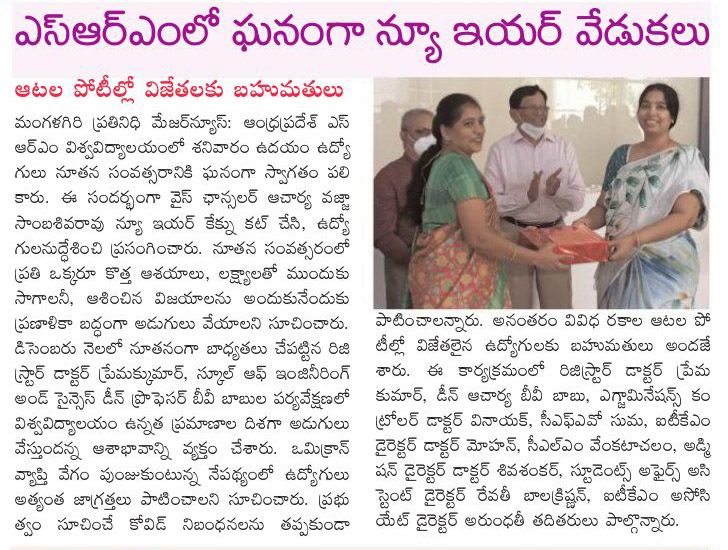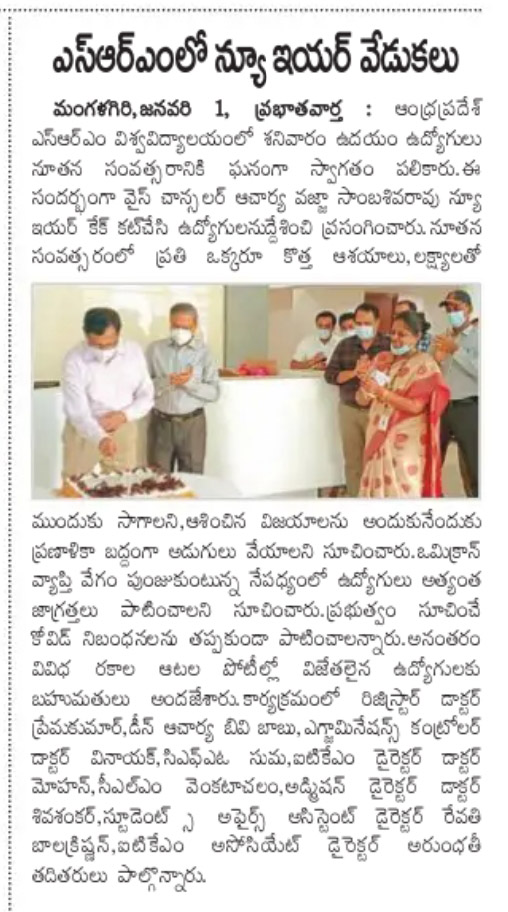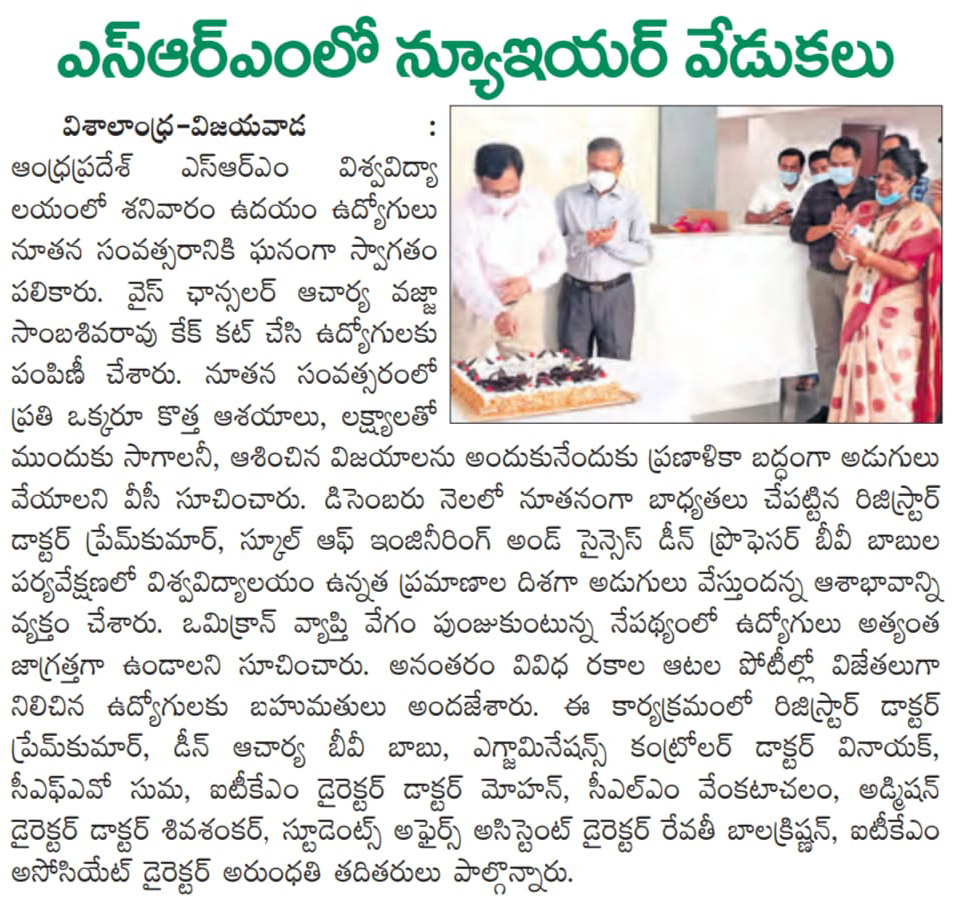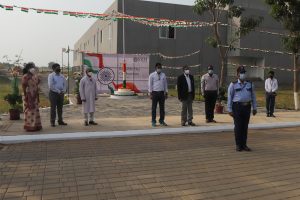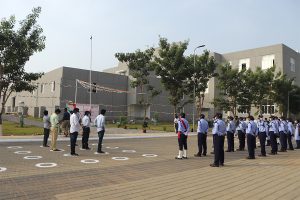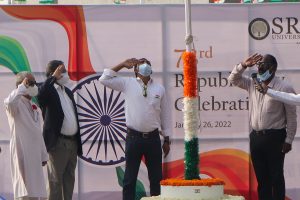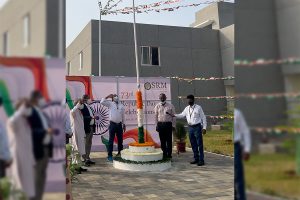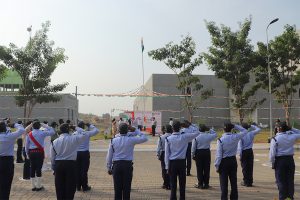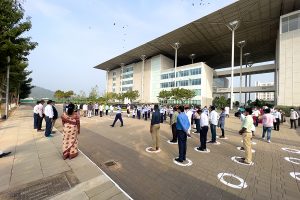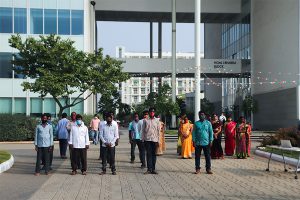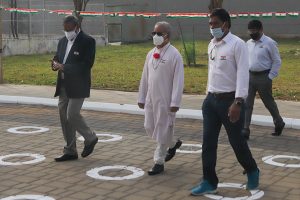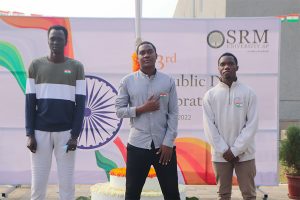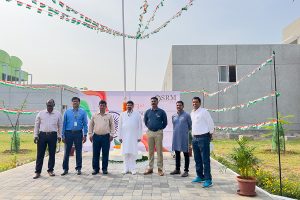All Management Events
- Startup incubated by BBA student crosses ₹1 crore turnover February 2, 2022
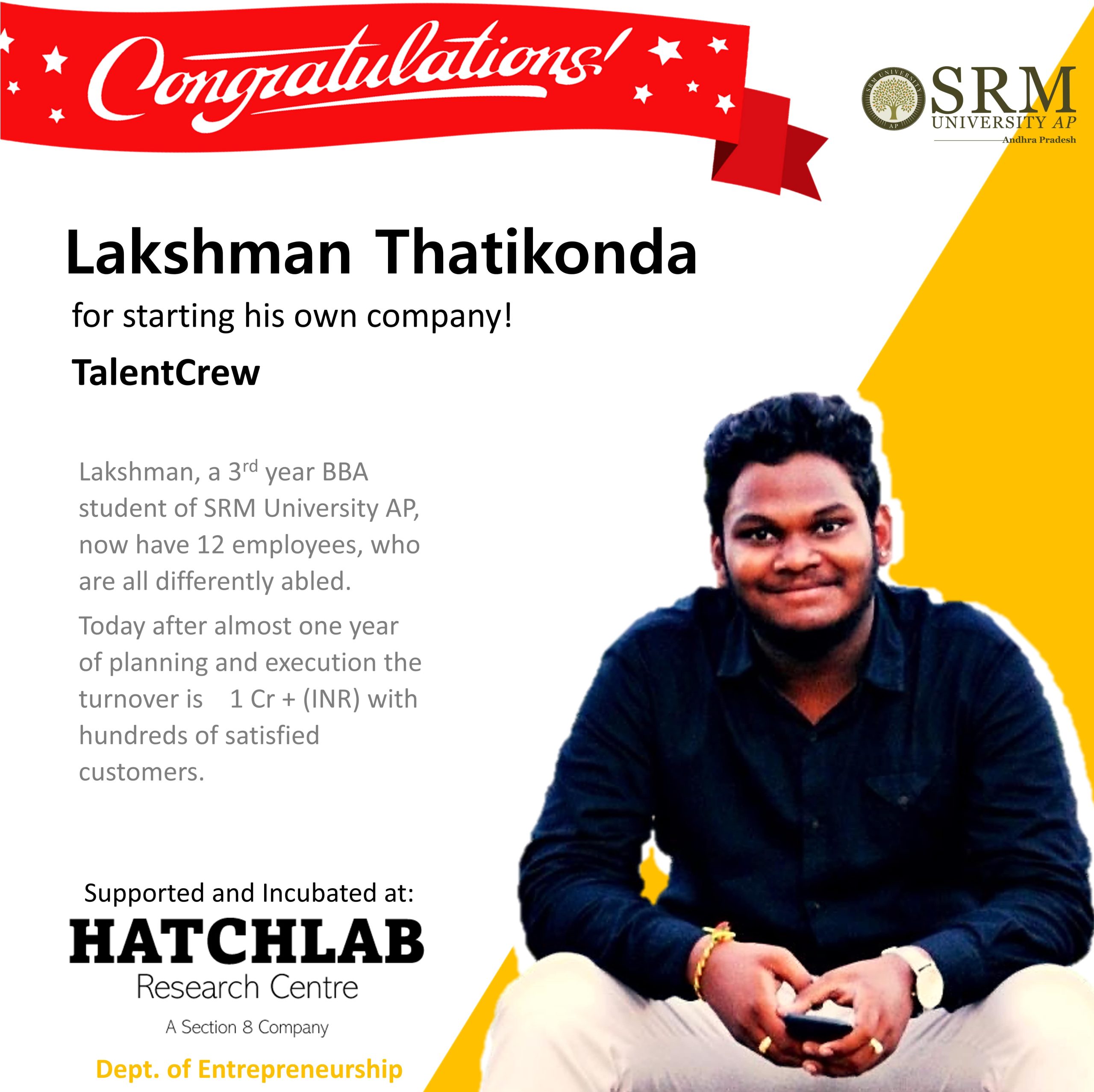 Mr Lakshman Thatikonda, a 3rd year BBA student of SRM University-AP, has started his own business venture (TalentCrew), incubated at the Hatchlab Research Centre– The technology and livelihood business incubator of SRM University-AP.
Mr Lakshman Thatikonda, a 3rd year BBA student of SRM University-AP, has started his own business venture (TalentCrew), incubated at the Hatchlab Research Centre– The technology and livelihood business incubator of SRM University-AP.The talent crew is a skill-based startup. They are one of India’s largest multi-category customised gifting companies, providing one of the best-curated collections of festival merchandise, gifts, handicrafts, wedding cards, carvings & personalised products for all occasions & festivals. TalentCrew has a global footprint with customers spanning 20 plus countries and the capability to deliver gifts to over 50 countries and 300 plus cities in India. Mr Lakshman started this organisation on the principles of creativity, agility, and social responsibility.
Over the next few years, TalentCrew envisions exploring and developing new products and services that will actively expand business while touching social responsibility.
Experience at Hatchlab Research Centre
The Hatchlab research centre aims to support SRM E-Cell’s mission of developing entrepreneurial talent and fostering the commercialisation of new ideas ventures. “Working with Hatchlab research centre was always a great experience. Here I found the fresh start for the innovation, and here the programme is very well structured with the right blend of practice,” says Mr Lakshman. “The best thing about this programme is that it allows me to learn while still being employed. And I always feel thankful for Dr Lakshmana Rao sir, for motivating me on every stand that I take, and Udayan Bakshi sir, for giving me such a wonderful opportunity” he added.
Continue reading → - Eco-friendly and economic production of Ammonia February 1, 2022
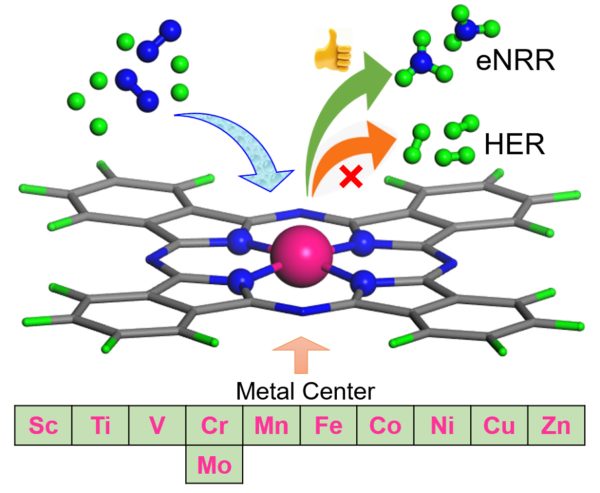 SRM Univeristy-AP is proud to announce that Prof. Ranjit Thapa, Department of Physics, has obtained a prestigious SERB-DST grant of Rs. 32 lakhs for a period of three years for his project, “Design Principle of Single Atom Catalyst for Nitrogen Fixation over HER: Energy Parameter, Electronic Descriptor and Database”.
SRM Univeristy-AP is proud to announce that Prof. Ranjit Thapa, Department of Physics, has obtained a prestigious SERB-DST grant of Rs. 32 lakhs for a period of three years for his project, “Design Principle of Single Atom Catalyst for Nitrogen Fixation over HER: Energy Parameter, Electronic Descriptor and Database”.Ammonia (NH3) is the prime source of fertilizers and an important carrier of energy too. Ammonia can be stored in its chemical form for a long and it is easy to transport. So now researchers are looking forward to using ammonia in place of hydrogen as an energy source. But the production of ammonia with existing techniques needs more energy compared to the energy it stored in its chemical bond. So, an alternative process that is environmentally friendly and cost-effective is needed to be in place.
In 2019 the global production capacity of ammonia is 235 million metric tons and will increase to 290 million metric tons by 2030. The importance of ammonia is due to its application in broad and diverse fields, such as fertilizers, textiles, pharmaceuticals, and is a carbon-free energy carrier. The Haber-Bosch process is used for the synthesis of ammonia (NH3) from N2 and H2 using Fe based catalyst. But the process emits carbon dioxide (CO2) (1.5 tons of CO2/tons of NH3 production) requires high pressure and temperature and consumes around 2% of the global supply of energy. Electrocatalytic N2 fixation (N2 + 6H+ + 6e− → 2NH3) showed great potential due to the possible use of atmospheric nitrogen and hydrogen derived from water through electrolysis and in mild conditions. However, the slow kinetics of N2 adsorption, splitting of the strong N≡N bond are the challenges for the electrocatalytic NRR process. In the electrocatalytic NRR process, the fast reaction kinetics of hydrogen evolution reaction is the greatest obstacle. To solve these challenges, the search for various types of catalysts is on the roll.
To date, trial and error methods have been used to synthesize the catalysts for the electrocatalytic NRR process. Thanks to the rapid development of density functional theory-based computational methods, the intermediate steps during NRR can be identified at the atomic level, the underlying principles can be understood, and a large space of catalysts can be checked for efficient NRR within a limited time. Without understanding the correct electronic structure of SAC and its correlation with the overpotential of NRR and defining the correct energy parameter to define “NRR over HER” and “N2 binding over H binding free energy”, we can never design the best catalyst cost-effectively. We will address these problems through this project’s objectives.
The project will help to design the best single-atom catalyst for the reduction of nitrogen (from the air) through the electrocatalytic process and convert it into ammonia. The designed catalyst can be synthesis by the industry and can be used for NRR.
This project will help a step forward towards more ammonia production for the uses in the agriculture sector, energy sector, and related sector.
- UDL 14 February 1, 2022
Andhra Jyothi – January 22

Andhra Prabha – January 22
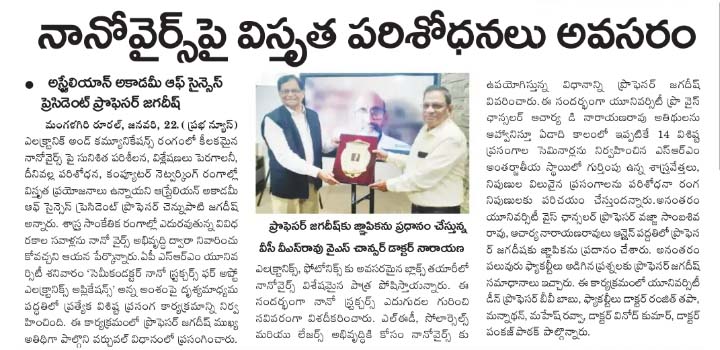
Manam Daily – January 22
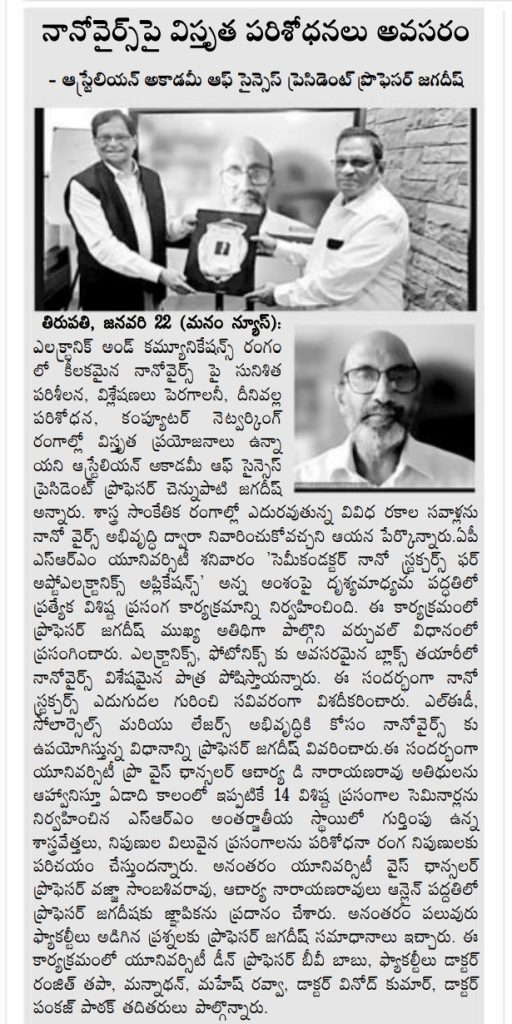
Praja Shakti – January 22
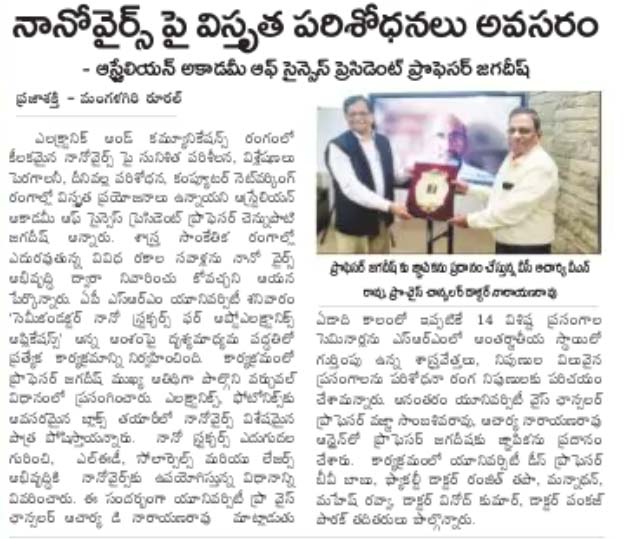
Surya Daily – January 22

Vartha – January 22
Continue reading →
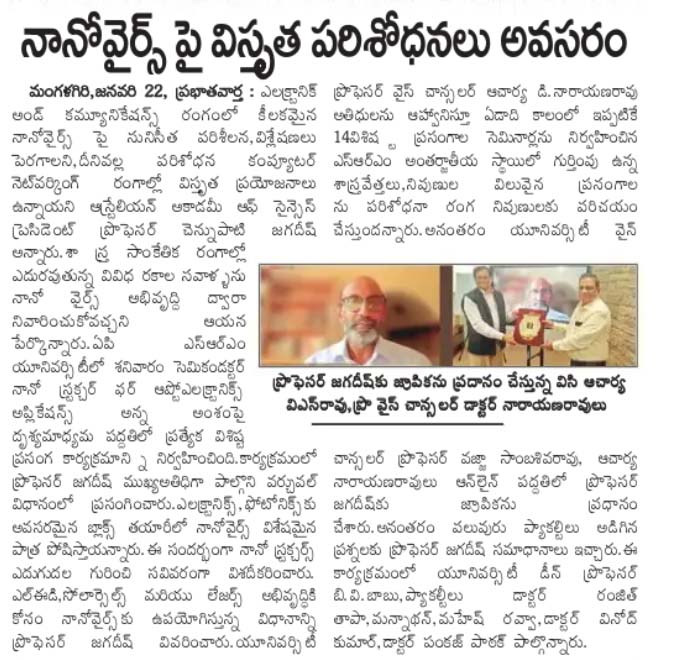
- Newyear celebrations at SRM University-AP February 1, 2022
- “Switch On Your Creativity”- Logo and Short Video Contest January 31, 2022
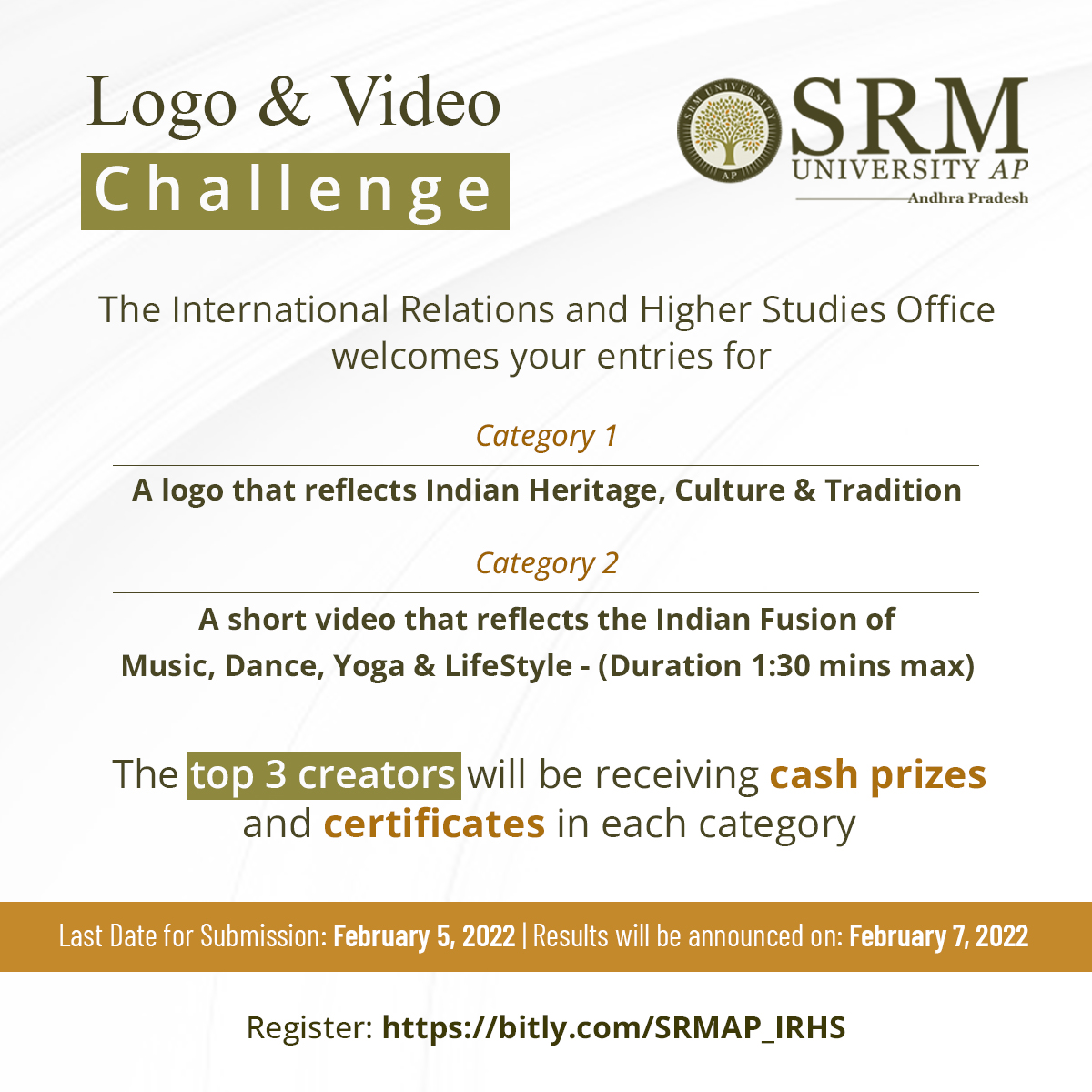
Office of International Relations and Higher Studies announces Logo and Short Video Contest – “Switch On Your Creativity “ on the theme of Indian Heritage and Culture.
Creative minds may submit/share a short video that summarises, interprets and expresses the rich culture and heritage of Indian arts, music, dance and lifestyle. A logo that reflects the same idea is also invited. Submit/Share your ideas/work to ir.office@srmap.edu.in
Winners will be awarded cash prizes worth Rs. 5000/- and certificates.
Logo First Prize: Rs.1500/-
Logo Second Prize: Rs. 1000/-
Logo Third Prize: Rs.500/-Video First Prize: Rs. 2500/-
Video Second Prize: Rs.1500/-
Video Third Prize: Rs.1000/-India is known around the world for its philosophy, culture, and traditions. And here is an opportunity to showcase/brush up on your knowledge of ancient India.
Only the finest creatives will be considered
Last Date for Submission:- February 05, 2022
Results will be announced on:- February 07, 2022
PS: You may submit your ideas/work to ir.office@srmap.edu.in
Continue reading → - Smart COVID-shield: An IoT driven reliable and automated prototype for Covid-19 symptoms tracking January 28, 2022
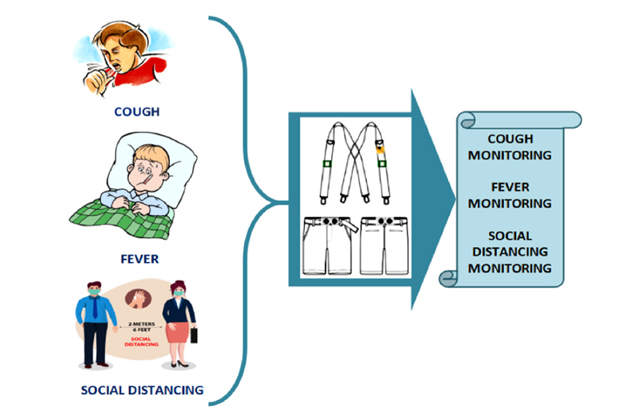 Persistent dry coughing and abnormally high body temperature are identified as more relevant risk factors associated with the COVID-19 crisis. Besides these, maintaining 6 feet social distancing norm was also recognized as a crucial factor. By taking these three features into consideration, the research group consisting of Dr Kshirasagar Sahoo, Assistant Professor, Department of Computer Science and Engineering at SRM University-AP have designed a smart, reliable and efficient COVID-19 tracking device model to monitor suspected infected people in public places. The device named “Smart COVID-Shield” utilising the IoT technology is equipped with a suspender and a belt to be placed over the clothes of the user which constitutes a cough detect unit, temperature detects unit and distance computing unit. Coughing and temperature patterns can be detected through the PIR sensor of the suspender while a belt with an ultrasonic sensor can be used to track people who violate the 6 feet social distancing norms in a real-time environment. A research paper titled “Smart COVID-shield: An IoT Driven Reliable and Automated Prototype for COVID-19 Symptoms Tracking” is published in Computing Journal as a part of the project.
Persistent dry coughing and abnormally high body temperature are identified as more relevant risk factors associated with the COVID-19 crisis. Besides these, maintaining 6 feet social distancing norm was also recognized as a crucial factor. By taking these three features into consideration, the research group consisting of Dr Kshirasagar Sahoo, Assistant Professor, Department of Computer Science and Engineering at SRM University-AP have designed a smart, reliable and efficient COVID-19 tracking device model to monitor suspected infected people in public places. The device named “Smart COVID-Shield” utilising the IoT technology is equipped with a suspender and a belt to be placed over the clothes of the user which constitutes a cough detect unit, temperature detects unit and distance computing unit. Coughing and temperature patterns can be detected through the PIR sensor of the suspender while a belt with an ultrasonic sensor can be used to track people who violate the 6 feet social distancing norms in a real-time environment. A research paper titled “Smart COVID-shield: An IoT Driven Reliable and Automated Prototype for COVID-19 Symptoms Tracking” is published in Computing Journal as a part of the project.Abstract of the paper:
IoT technology is revolutionizing healthcare and is transforming it into more personalized healthcare. In the context of the COVID-19 pandemic, IoT’s intervention can help to detect its spread. This research proposes an effective “Smart COVID-Shield” that is capable of automatically detecting prevalent symptoms like fever and coughing along with ensuring social distancing norms are properly followed. It comprises three modules which include Cough Detect Module (CDM) for dry cough detection, Temperature Detect module (TDM) for high-temperature monitoring, and Distance Compute Module (DCM) to track social distancing norm violator. The device comprises a combination of a lightweight fabric suspender worn around the shoulders and a flexible belt wrapped around the waist. The suspender is equipped with a passive infrared (PIR) sensor and temperature sensor to monitor persistent coughing patterns and high body temperature and the ultra-sonic sensor verify 6 feet distance for tracking an individual’s social distancing norms. The developed model is implemented in an aluminium factory to verify its effectiveness. Results obtained were promising and reliable when compared to conventional manual procedures. The model accurately reported when body temperature rises. It outperformed thermal gun as it accurately recorded a mean of only 4.65 candidates with higher body temperature as compared to 8.59% with the thermal gun. A significant reduction of 3.61% on social distance violators was observed. Besides this, the latency delay of 10.32 s was manageable with a participant count of over 800 which makes it scalable.
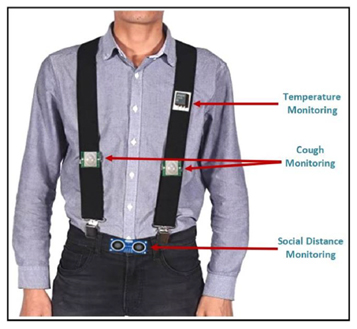
This is a collaborative work of H. K. Tripathy, S. Mishra from School of Computer Engineering, KIIT Deemed to Be University, Bhubaneswar, Odisha, India and A. Nayyar from Graduate School, Faculty of Information Technology, Duy Tan University, Da Nang 550000, Vietnam.
Early detection of the coronavirus symptoms is one feasible means to restrict the spreading of coronavirus. The IoT enabled “Smart COVID-Shield” is developed and implemented in this study to monitor social distancing violators in crowded places. In future, all other COVID symptoms can be incorporated into the model to make it more effective and real-time. An emergency alert module can also be included as part of the model to create awareness among people. An enhanced security mechanism can be further embedded in the working model to prevent any data compromise and dilution in data availability.
Continue reading → - Facebook Metaverse Spark AR Hackathon Winners January 27, 2022
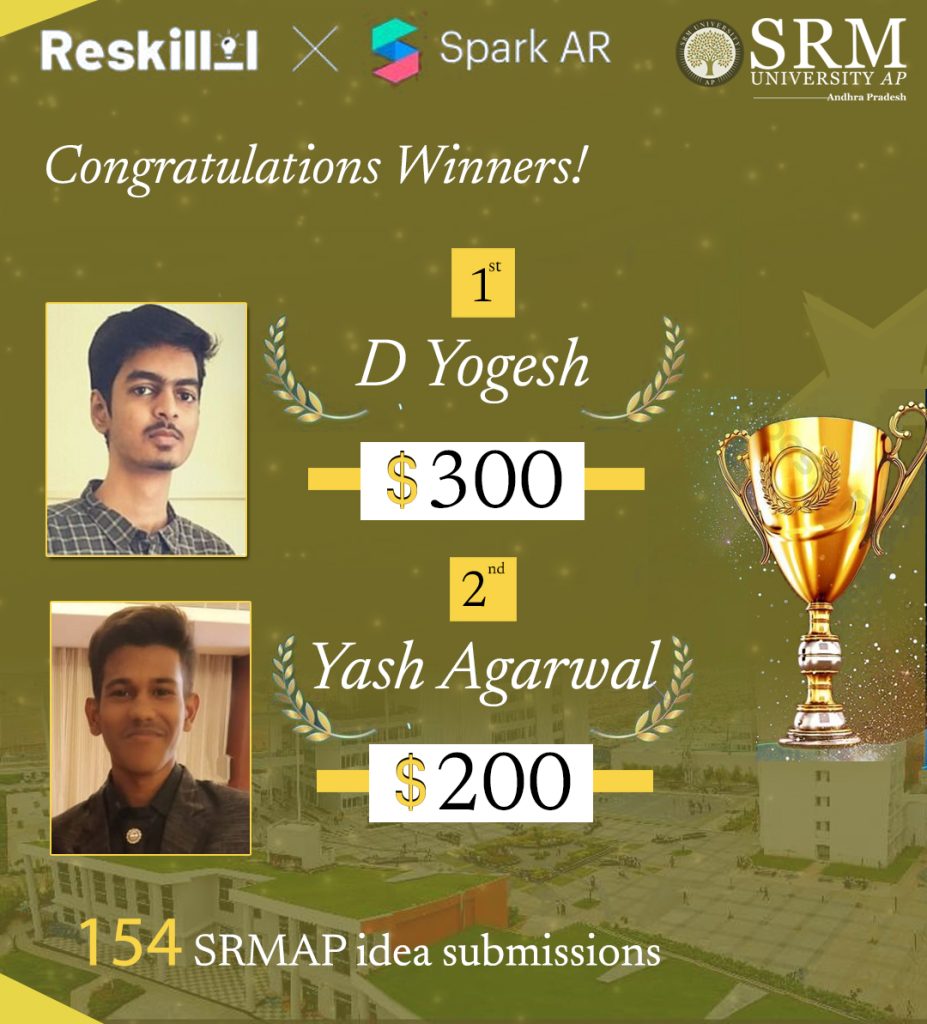 Skilling up is always encouraged at SRM University-AP. With cutting-edge technology and premier instructors provided to support curious, enthusiastic, and innovative minds, skilling up is fun, fantastic, and comes with fabulous prizes too.
Skilling up is always encouraged at SRM University-AP. With cutting-edge technology and premier instructors provided to support curious, enthusiastic, and innovative minds, skilling up is fun, fantastic, and comes with fabulous prizes too.In the Metaverse Spark AR Hackathon conducted by Meta (Facebook), D Yogesh and Yash Agarwal have bagged the winner’s and runner’s up prizes of $300 and $200 respectively. Not just that, 154 of our students would take away from this competition lucrative goodies and participation certificates for their idea submissions.
The CR&CS department organized workshops and trained our students specifically for this event alongside their regular upskilling for placements and other hackathons and contests.
Over a huge number of students who participated in this contest from different corners of the globe, the students of SRMAP walking away with the prizes make a sizable chunk.
We extend our heartfelt wishes to all the participants and hope to see them ace every challenge they face with the knowledge imparted and the skills honed here.
Testimonials
“It was my first hackathon that I participated in and being a part of the SRM AP Hackathon Club has helped and motivated me greatly. Having an interest in AR/VR, this AR hackathon offered me a good opportunity to learn more about the technology. I attended a workshop, conducted by Meta where they introduced us to Augmented Reality. I learned how Instagram filters were made from scratch, and, in addition, I gained technical knowledge about Augmented Reality. I made an Instagram filter that was based on the PUBG Mobile game.
As part of the hackathon, I would like to thank the CR&CS department for the smooth conduction of the hackathon. Also, I would like to thank Priyanka ma’am (link here) and Raghunathan sir (link here) for their time and assistance in the process. I’m very happy that I have acquired a new skill and looking forward to contributing to the Metaverse! Explore the 4.0 technologies”
-Yogesh D
“The hackathon was about creating an AR effect. I made an AR effect on the theme based upon the popularly known web series “SQUID GAMES”.
A special thanks to one of my friends, S. Lokesh who helped me a lot to make me understand how to make an AR effect. I would like to thank Dr T. Raghunathan and Dr Priyanka from the SRM-AP Hackathon club for encouraging and guiding me to participate in this competition.
I am eagerly waiting for many more Hackathons wherein I can participate under the guidance of the SRM-AP hackathon club. Winning doesn’t matter, but participation matters”
-Yash Aggarwal
- 73rd Republic Day Celebrations January 27, 2022
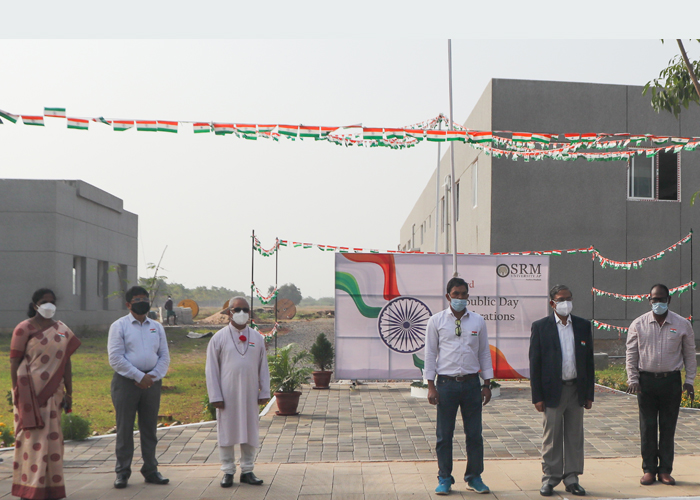 On January 26, 2022 at 9.00 am IST, SRM University-AP celebrated 73rd Republic Day Celebrations with a display of strong unwavering patriotism with all protocols in place. All the staff members and students came together virtually to honour our constitution, our culture, and the celebration of our unity in diversity.
On January 26, 2022 at 9.00 am IST, SRM University-AP celebrated 73rd Republic Day Celebrations with a display of strong unwavering patriotism with all protocols in place. All the staff members and students came together virtually to honour our constitution, our culture, and the celebration of our unity in diversity.The event was an auspiciously planned by the Department of Student Affairs. The flag was unfurled and it was followed by the National Anthem.
- The priority was given towards good health and good physical practices on this Republic Day and a note on the importance and providence of Yoga was provided by Dr Venkat Nori who then guided everyone through the various steps of Surya Namaskar. Dr Nori’s elaborate and passionate detailing of integrating Yoga into our 21st Century Lifestyle with a refreshing take on its growing necessity was a crucial message to not only the students of SRMAP but to the country as a whole.
- The song by Sowmyadeep in his ethreal voice and with the heart pulling lyrics of “Desh Mere” brought a flair of lightness to the occasion.
- In an incredible show of solidarity and togetherness with the whole country and with the SRMAP digital version of the Republic Day parade the students worked hard and prepared informative State Tableaus to represent and celebrate our diversity.
- The dances by Navya and Prasanna transported us out to a world of music and beauty with a show of the creative range that our students have that extends beyond their academics.
- The song by Sruthi was another delicately woven melody that pulled on our heart stings. It was nostalgic and reminded us about what we as a country are striving towards.
- The short movie on Freedom by Movie club was remarkable in executing such brilliance despite the social distancing restrictions in place and is a show of our collective creative strength in face of challenges.
The event came to a close with a mixture of touching and motivating moments. It brought our love for our country and our responsibilities towards it to the forefront of our mind. But most importantly, it gave us the optimism to make our country a better place as we tackle the adversities of today and stay connected.
Continue reading → - On prospective memory and aging in medical adherence January 25, 2022
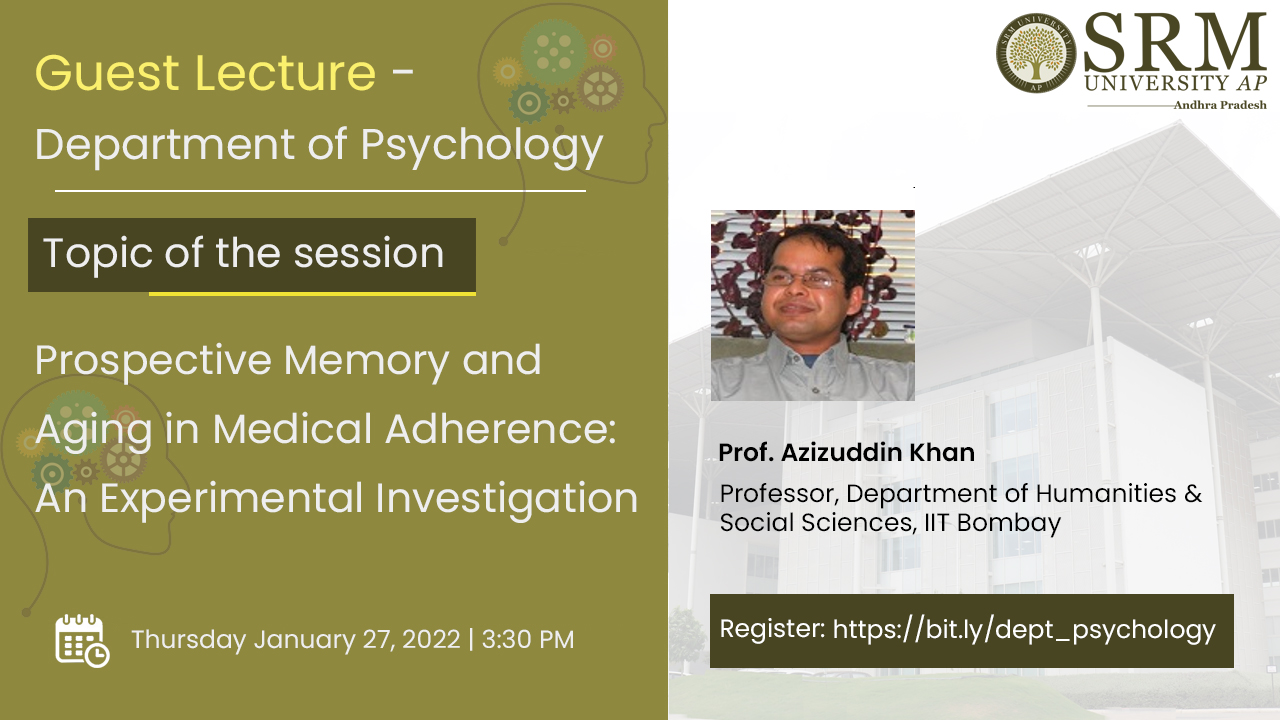 The Department of Psychology is organising a guest lecture on the topic “Prospective Memory and Aging in Medical Adherence: An Experimental Investigation”. Prof Azizuddin Khan, Professor at the Department of Humanities & Social Sciences, IIT Bombay will engage the audience on Thursday, January 27, 2022, from 03.30 to 04.30 pm.
The Department of Psychology is organising a guest lecture on the topic “Prospective Memory and Aging in Medical Adherence: An Experimental Investigation”. Prof Azizuddin Khan, Professor at the Department of Humanities & Social Sciences, IIT Bombay will engage the audience on Thursday, January 27, 2022, from 03.30 to 04.30 pm.There are several studies happening across the world regarding implications of theoretical models and empirical findings associated with laboratory studies of prospective memory for medication adherence behaviours. Memory is a fickle thing; it changes as we age. Learn more by joining this session on January 27, 2022, at 3.30 pm.
About the Speaker
Dr Azizuddin Khan is currently a Professor in Psychophysiology and Cognitive Psychology at the Department of Humanities and Social Sciences at the Indian Institute of Technology Bombay (IITB). He is heading Psychophysiology Laboratory. He was visiting faculty at the Department of Psychology, University of Jyvaskyla, Finland from August 2004 – December 2005, Aligarh Muslim University Aligarh, India 2015-17, Department of Psychology, University of Warsaw, Poland 2018. He has research interests in the field of Environmental Psychology, Polar Research, Developmental Neuropsychology, emotion regulation, Prospective Memory, and Developmental Dyslexia by using biofeedback and electrophysiological method. While teaching interest lies in the fields are Cognitive Psychology, Educational Psychology, Human Cognitive Processes, Developmental Neuropsychology, Biological Psychology, Cognitive Ergonomics and Research Methodology Dr Khan has done his graduation and post-graduation from Aligarh Muslim University, (AMU) Aligarh with first division in 1993 and 1995 respectively. He has qualified UGC- NET, Junior Research Fellowship in December 1998, conducted by University Grant Commission, New Delhi. He has completed his PhD from IIT Kanpur on the topic of “Temporal Aspects of Prospective and Retrospective Memory” in 2006. He has also worked as a researcher at the Department of Psychology, University of Jyvskyla, Finland, from August 2004 to March 2005. Dr Khan is an eminent psychologist, prolific writer and author of many books. He is recipient several visiting researcher fellowships such as Hermes Fellowship, DAAD, INSA, EMINTE, ICSSR etc. Dr Khan has published more than 4 dozen peer-reviewed international journals especially in the field of emotion regulation and developmental disorders.
Continue reading → - Some Fascinating Features of Water Wave Propagation and Dissipation: A Mathematical Viewpoint January 24, 2022
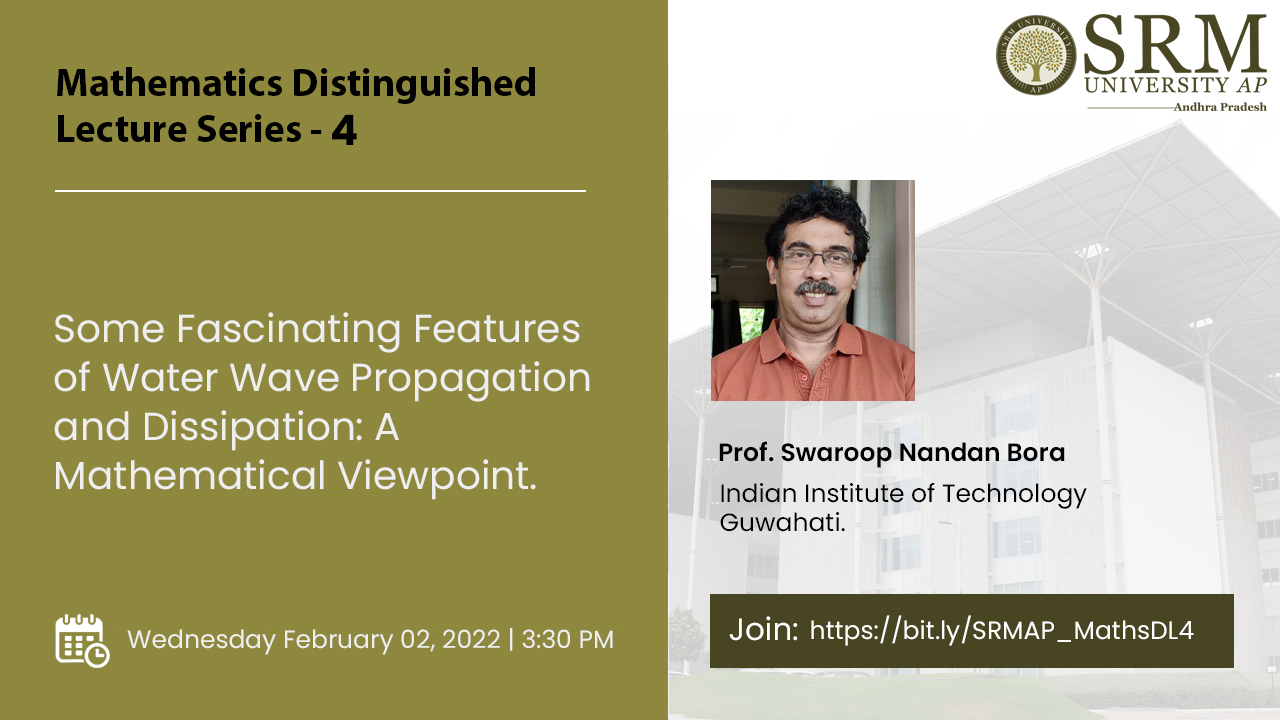 The Department of Mathematics is going to host the fourth instalment of the Distinguished Lecture on February 2, 2022, at 3:30 PM with Prof Swaroop Nandan Bora from the Indian Institute of Technology Guwahati as the keynote speaker. Dr Bora will be speaking on “Some Fascinating Features of Water Wave Propagation and Dissipation: A Mathematical Viewpoint”.
The Department of Mathematics is going to host the fourth instalment of the Distinguished Lecture on February 2, 2022, at 3:30 PM with Prof Swaroop Nandan Bora from the Indian Institute of Technology Guwahati as the keynote speaker. Dr Bora will be speaking on “Some Fascinating Features of Water Wave Propagation and Dissipation: A Mathematical Viewpoint”.Prof Swaroop Nandan Bora received his PhD in Mathematics from Dalhousie University in Halifax, Canada. He joined the Department of Mathematics, Indian Institute of Technology Guwahati in 1999. He is also the youngest son of the renowned novelist and Padma Shri recipient Lakshmi Nandan Bora.
Prof Bora’s research interest includes Water Wave Mechanics, River Mechanics, Sloshing Dynamics, Flow through Porous Media, Differential Equation, Fractional Differential Equation. He has been elected to don the cap of the President of the Indian Society of Theoretical and Applied Mechanics (ISTAM).
Some Fascinating Features of Water Wave Propagation and Dissipation: A Mathematical Viewpoint:
Long since oceans have been serving mankind in various ways and of course, at the same time, the waves have also shown their fury at times by claiming lives and creating huge destruction. In order to understand the oceans and the strength they display through waves, it becomes very pertinent to study ocean waves, their behaviour and effects with respect to wave propagation, scattering, damping, trapping etc., which influence a number of issues in connection with marine structures and coastal regions. The comfortable situation to work with ocean waves is by considering simple conditions thereby neglecting many important aspects such as the porosity of the structures that are installed in the ocean for various activities, the porous and elastic effects of the sea-bed and also the unevenness of the sea-bed. However, the real situation demands that some or all of these be taken into account while modelling a problem so that the problem is formulated for a more realistic scenario.
In order to reduce the wave impact on marine structures (i.e., to dissipate the wave effects), it is essential that the structures (such as cylinders, barriers, caissons) possess in them the ability to reflect the wave and help in attenuating the wave energy. This brings into fore the utility of porous structures which can be used as breakwaters in the coastal and offshore regions for various applications. Further, it is practically impossible to find sea-beds that are flat and do not possess any porosity or elasticity. In other words, a more realistic formulation can be carried out by considering structures possessing porosity, and sea-beds being uneven and possessing porosity and/or elasticity.
The objective of this talk is to discuss the scattering of water waves by various types of porous structures placed on flat or uneven sea-bed which may possess porosity and/or elasticity. The study focuses on how reflection varies when different important parameters are changed. The observations made from this study will allow one to design structures that will be effective enough to reduce wave impact on the structures. In this talk, some results will be displayed which portray the physical scenario. An attempt will be made to present some practical problems which take into account a number of important properties and parameters so that the results become practical to be followed by relevant people for various activities with regard to protecting certain regions and structures from harsh ocean wave action. It will mainly emphasize the significant role that porosity and elasticity play with regard to ocean wave propagation and various related issues. The emphasis will be on the modelling of the problems which will establish the essence of mathematics.
A brief and friendly introduction to water wave propagation will precede the main components of the talk to give some general idea to the audience.
Join the exciting Lecture on February 2, 2022, at 3:30 PM with Prof Swaroop Nandan Bora.
Continue reading →



